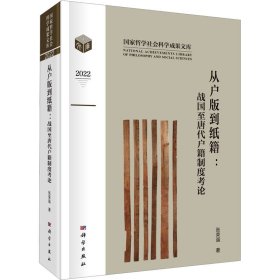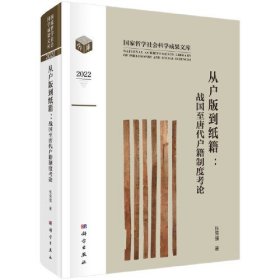
从户版到纸籍:战国至唐代户籍制度考论
批量上传,套装书可能不全,下单前咨询在线客服!有特殊要求,下单前请咨询客服!
¥ 97.8 4.9折 ¥ 198 全新
库存24件
作者张荣强
出版社科学出版社
ISBN9787030751751
出版时间2023-10
装帧精装
开本16开
定价198元
货号29642827
上书时间2024-11-04
- 最新上架
商品详情
- 品相描述:全新
- 商品描述
-
导语摘要
中国古代户籍制度是国家掌握人口、征调赋役、管控社会秩序的基本手段。以唐代两税法承认客籍为标志,中国古代户籍的著录对象、编制原则乃至管理系统都发生了划阶段的重大变化。本书综合利用出土文献与传世文献,融通简牍学与敦煌吐鲁番学的研究,在全面系统整理战国至唐代中期户籍文书的基础上,以专题形式对这一时期户籍制度的发展演化及其相应的社会结构变化进行实证考察和理论分析,并从简纸更替这一全新视角揭示中古时期伴随着书写材料的改变,国家行政制度和社会控制方式相应发生的重大变化。
目录
目录
序一李治安 / 001
序二孙继民 / 005
前言 / 013
第一编 财政年度·造籍日期与官方年龄
第一章 汉唐间财政年度演变新论
一问题的提出 / 004
二秦汉“计稻后年”与孙吴财政年度变化 / 005
三郴州晋简与西晋预算体制的初步确立 / 016
第二章 从“岁尽增年”到“岁初增年”——中国中古官方计龄方式的演变
一“岁尽增年”与周岁、虚岁之争 / 030
二“岁尽增年”与“著籍增年” / 035
三古代礼俗上的“岁首增年” / 039
四唐代的手实申报与“岁首增年” / 043
五秦汉与唐代官方年龄及户籍记载上的差异 / 048
结语 / 054
补记 / 055
第二编 文书考释与研究
第三章 湖南里耶所出“秦代迁陵县南阳里户版”研究
一户籍简的著录格式 / 062
二户籍简的制作年代 / 068
三南阳里户版的性质 / 074
附录秦代迁陵县南阳里户版 / 083
第四章 长沙东牌楼东汉“户籍简”补说
一“算卒”释义 / 087
二“户籍简”的形制与著录格式 / 094
三“户籍简”的性质 / 097
第五章 长沙吴简中两类户籍簿的功能与性质
一“右某家口食”类简的“不任调”与“应役民” / 104
二“凡口若干”类结句简中的“事” / 115
三“凡口若干”与“右某家口食”类简的功用 / 124
补论“右某家口食”户籍簿的性质 / 128
第六章 甘肃临泽晋简中的家产继承与户籍制度——兼论两晋十六国户籍的著录内容
一简册释文与内容分析 / 144
二案件争讼焦点与汉晋分家制度 / 148
三两晋十六国户籍的著录内容 / 154
第七章 《前秦建元二十年籍》与汉唐间籍帐制度的变化
一《前秦建元二十年籍》内容分析 / 163
二造籍日期与财政年度的调整 / 171
三户籍文书类型及其功用的转变 / 176
补论有关《前秦建元二十年籍》的录文问题 / 186
第八章 《西凉建初籍》与魏晋时期的职役户籍
一《西凉建初籍》非民籍、吏兵籍 / 193
二“大府吏”“散”的身分 / 199
三魏晋兵户居住状态与《西凉建初籍》的性质 / 204
第九章 新疆吐鲁番新出唐代貌阅文书
一文书释读与定名 / 211
二唐代的貌阅时间与貌阅年龄 / 213
三貌阅的重点对象及对不法行为的处罚 / 221
第三编 课役与身分
第十章 “小”“大”之间——战国至西晋课役身分的演进
一问题的提出 / 231
二课役身分从“二分”到“三分” / 234
三汉代的课役身分体系 / 245
四从课役身分到户籍身分 / 252
第十一章 魏晋时期的吏户与吏籍
一关键史料的解读 / 259
二古代户籍编制原则与吏、民合籍 / 267
三吏户的义务、身分与地位 / 274
结语 / 282
第十二章 唐代敦煌籍的成年“中女”与吐鲁番籍的“丁女”
一唐代敦煌籍的成年“中女”并非书写疏误 / 284
二“丁从课役”与北朝系统下女子的“丁中” / 287
三西晋及东晋南朝的“丁女”称谓与吐鲁番籍中的遗存 / 292
余论 / 298
第十三章 从户下奴婢到在籍贱民——中国古代奴婢身分的演变与良贱身分制的形成
一秦汉时期的户口统计与奴婢的附籍性质 / 302
二魏晋以降的户口统计与奴婢在籍身分 / 313
三秦汉奴婢的来源与身分变化 / 320
四良贱身分制的形成与发展 / 326
结语 / 333
第四编 简纸更替与制度演进
第十四章 西晋黄籍考——以《太平御览·文部·札》引《晋令》为中心
一黄籍是简还是纸? / 339
二“诸户口黄籍” / 346
三黄籍与正户 / 353
第十五章 中国古代书写载体与户籍制度的演变
一“简”“牍”之别与以简代牍 / 365
二从“户版”到“户籍” / 370
三简纸替代与中古造籍制度的演进 / 379
第十六章 简纸更替与中国古代基层统治重心的上移
一简牍时代的帐簿编造与正、副本关系 / 388
二秦汉时期乡吏统揽基层事务 / 393
三简纸替代与县、乡行政机构的变化 / 401
四魏晋隋唐时期县司亲理庶务 / 405
余论 / 413
结论战国以降户籍制度的形成与发展 / 416
主要参考文献 / 430
索引 / 461
后记 / 474
CONTENTS
PREFACE 1 / 001
PREFACE 2 / 005
FOREWORDS / 013
PART I FISCAL YEAR, DATE OF REGISTRATION AND OFFICIAL AGE
CHAPTER 1 A NEW STUDY OF THE FISCAL YEAR EVOLUTION FROM THE HAN DYNASTY TO TANG DYNASTY
Section 1 Introduction / 004
Section 2 The “Calculating Rice Harvests for the Following Year” in the Qin-Han Period and the Changes of the Fiscal Year System in the Wu Kingdom / 005
Section 3 The Chenzhou Bamboo Documents of Jin Dynasty and the Preliminary Establishment of the Budget System in the Western Jin Dynasty / 016
CHAPTER 2 FROM “COUNTING FROM THE END OF YEAR” TO “COUNTING FROM THE BEGINNING OF THE YEAR”: THE EVOLUTION OF THE OFFICIAL AGE COUNTING METHOD IN MIDDLE ANCIENT CHINA
Section 1 The “Counting from the End of Year” and the Debate between the use of Zhousui (Counting Age by Years) and Xusui (Counting Age by Lunar Years) / 030
Section 2 The “Counting from the End of Year” and the “Counting from the Registration” / 035
Section 3 The “Counting from the Beginning of the Year” in the Ancient Ritual Custom / 039
Section 4 The Report of Household Information in the Tang Dynasty and the “Counting from the Beginning of the Year” / 043
Section 5 The Differences in Official Age and Household Register Records between the Qin-Han Period and the Tang Dynasty / 048
Conclusion / 054 Supplementary Recording / 055
PART II INTERPRETATION AND RESEARCH OF THE DOCUMENTS
CHAPTER 3 THE STUDY ON THE “NANYANG LI HOUSEHOLD REGISTRATION BAMBOO SLIPS OF QIANLING COUNTY IN THE QIN DYNASTY” EXCAVATED AT LIYE OF HUNAN PROVINCE
Section 1 The Format of the Household Registration Bamboo Slips / 062
Section 2 The Production Time of the Household Registration Bamboo Slips / 068
Section 3 The Nature of the Nanyang Li Household Registration Bamboo Slips / 074
Appendix Nanyang Li Household Registration Bamboo Slips of Qianling County in the Qin Dynasty / 083
CHAPTER 4 A FUTHER STUDY ON THE EASTERN HAN DYNASTY HOUSEHOLD REGISTRATION BAMBOO SLIPS OF DONGPAILOU AT CHANGSHA
Section 1 The Interpretation of Suanzu / 087
Section 2 The Shape and Format of the Household Registration Bamboo Slips / 094
Section 3 The Nature of the Household Registration Bamboo Slips / 097
CHAPTER 5 THE FUNCTION AND NATURE OF THE TWO TYPES OF HOUSEHOLD REGISTRATION DOCUMENTS IN THE CHANGSHA WU KINGDOM BAMBOO SLIPS
Section 1 The Terms Bu rendiao and Yingyi min in the You moujia koushi Bamboo Slips / 104
Section 2 The Term Shi in the Household Registration Bamboo Slips Ending with Fan kou ruogan / 115
Section 3 The Function of the Fan kou ruogan-type and You moujia koushi-type Bamboo Slips / 124
Supplementary Discussion The Nature of Household Register of You moujia koushi-type / 128
CHAPTER 6 THE FAMILY PROPERTY INHERITANCE AND HOUSEHOLD REGISTRATION SYSTEM IN THE LINZE OF GANSU JIN DYNASTY BAMBOO DOCUMENTS: CONCURRENT DISCUSSION ON THE CONTENTS OF THE HOUSEHOLD REGISTRATION OF THE JIN DYNASTY AND SIXTEEN-STATE PERIOD
Section 1 The Text Interpretation and Analysis of the Bamboo Slips / 144
Section 2 The Focus of Legal Dispute and the System of Dividing Families during the Han and Jin Dynasties / 148
Section 3 The Contents of the Household Registration of the Jin Dynasty and Sixteen-State Period / 154
CHAPTER 7 THE QIANQIN JIANYUAN ERSHINIAN JI AND THE CHANGES IN THE HOUSEHOLD REGISTRATION SYSTEM FROM THE HAN DYNASTY TO TANG DYNASTY
Section 1 The Analysis of the Content of the Qianqin Jianyuan Ershinian Ji / 163
Section 2 The Date of Registration Recorded and the Adjustment of the Fiscal Year / 171
Section 3 The Household Registration Document Types and the Transformation of Their Functions / 176
Supplementary Discussion The Related Issues of the Qianqin Jianyuan Ershinian Ji Interpretation / 186
CHAPTER 8 THE XILIANG JIANCHU JI AND THE SERVICE AND HOUSEHOLD REGISTRATION IN THE WEI-JIN PERIOD
Section 1 The Xiliang Jianchu Ji Is Not a Commoner-Household Register or a Lower Official and Soldier Household Register / 193
Section 2 The Status of Dafuli and San / 199
Section 3 The Residential Status of Soldier Households in the Wei-Jin Period and the Nature of the Xiliang Jianchu Ji / 204
CHAPTER 9 THE NEWLY EXCAVATED MANUSCRIPT DOCUMENTS OF VISUAL INSPECTION OF THE TANG DYNASTY IN TURPAN PREFECTURE, XINJIANG UYGURAUTONOMOUS REGION
Section 1 The Interpretation and Naming of the Manuscript Documents / 211
Section 2 The Time and Age of Visual Inspection of the Tang Dynasty / 213
Section 3 The Key Targets of Visual Inspection and Punishment for Illegal Behavior / 221
PART III CORVéE LABOR SERVICE AND IDENTITY
CHAPTER 10 BETWEEN “SMALL” AND “BIG”: EVOLUTION OF THE IDENTIFICATION OF CORVéE LABOR SERVICE FROM THE WARRING STATES PERIOD TO THE WESTERN JIN DYNASTY
Section 1 Introduction / 231
Section 2 The Evolution of the Two-Grade to Three-Grade Corvée Labor Service System / 234
Section 3 The Identity of Corvée Labor Service System in the Han Dynasty / 245
Section 4 From the Identity of Corvée Labor Service to the Identity of Household Registration Status / 252
CHAPTER 11 CORVéE HOUSEHOLDS AND CORVéE HOUSEHOLD REGISTRATION IN THE WEI-JIN PERIOD
Section 1 The Interpretation of the Key Historical Texts / 259
Section 2 The Compilation Principles of Ancient Household Registration and the Combination of Corvée and Commoner Household Registration / 267
Section 3 Obligations, Identity, and Status of Corvée Households / 274
Conclusion / 282
CHAPTER 12 ZHONG WOMEN AT DUNHUANG AND DING WOMEN AT TURPAN IN THE HOUSEHOLD REGISTER DOCUMENTS OF TANG DYNASTY
Section 1 The Zhong Women at Dunhuang in the Household Register Documents of Tang Dynasty Is Not a Mistake in Recording / 284
Section 2 “Ding cong keyi” and the Dingzhong Women in the Northern Dynasties’ System / 287
Section 3 The Title Ding Women during the Western Jin, Eastern Jin Dynasties and the Southern Dynasties and Surviving Records from the Turpan Household Register Documents / 292
Epilogue / 298
CHAPTER 13 FROM HOUSE SERFS TO REGISTERED PARIAHS: THE IDENTITY TRANSITION OF HOUSE SERFS AND THE FORMATION OF THE LIANGJIAN IDENTITY SYSTEM IN ANCIENT CHINA
Section 1 The Household Census in the Qin-Han Period and the Attached Identity of House Serfs / 302
Section 2 The Household Census since Wei-Jin Period and the Registered Identity of House Serfs / 313
Section 3 The Origins of the House Serfs in the Qin-Han Period and Their Identity Changes / 320
Section 4 The Formation and Development of the Liangjian Identity System / 326
Conclusion / 333
PART IV REPLACEMENT OF BAMBOO-SLIP AND PAPER AND INSTITUTIONAL EVOLUTION
CHAPTER 14 THE STUDY ON THE HUANGJI IN THE WESTERN JIN DYNASTY: BASED ON THE JINLING QUOTED IN THE TAIPINGYULAN WENBU ZHA
Section 1 Are the Huangji Written on Bamboo Slips or Paper? / 339
Section 2 “All Households are Recorded in the Yellow-paper Household Registration Documents” / 346
Section 3 The Huangji and the Official Household / 353
CHAPTER 15 THE EVOLUTION OF THEWRITINGCARRIER AND HOUSEHOLD REGISTRATION SYSTEM IN ANCIENT CHINA
Section 1 The Difference between Bamboo Slip and Tablet, and the Substitution of Tablet by Bamboo Slip / 365
Section 2 The Household Registration Writing Carrier is from Bamboo Slip/Wooden Tablet to Paper / 370
Section 3 The Transition from Bamboo Slips to Paper and the Evolution of the Household Registration System in Middle Ancient Period / 379
CHAPTER 16 THE TRANSITION FROM BAMBOO SLIPS TO PAPER AND THE UPWARD MOVEMENT OF PRIMARY-LEVEL GOVERNING CENTERS IN ANCIENT CHINA
Section 1 The Document Compilation during t
相关推荐
-

从户版到纸籍:战国至唐代户籍制度考论
全新广州
¥ 131.11
-

从户版到纸籍:战国至唐代户籍制度考论
全新南京
¥ 142.56
-

从户版到纸籍:战国至唐代户籍制度考论
全新广州
¥ 131.12
-

从户版到纸籍:战国至唐代户籍制度考论
全新广州
¥ 131.12
-

从户版到纸籍:战国至唐代户籍制度考论
全新保定
¥ 121.20
-

从户版到纸籍:战国至唐代户籍制度考论
全新广州
¥ 131.10
-

从户版到纸籍:战国至唐代户籍制度考论
全新广州
¥ 109.97
-

从户版到纸籍:战国至唐代户籍制度考论
全新成都
¥ 99.30
-

从户版到纸籍:战国至唐代户籍制度考论
全新广州
¥ 131.18
-

从户版到纸籍:战国至唐代户籍制度考论
全新北京
¥ 128.21
— 没有更多了 —












以下为对购买帮助不大的评价